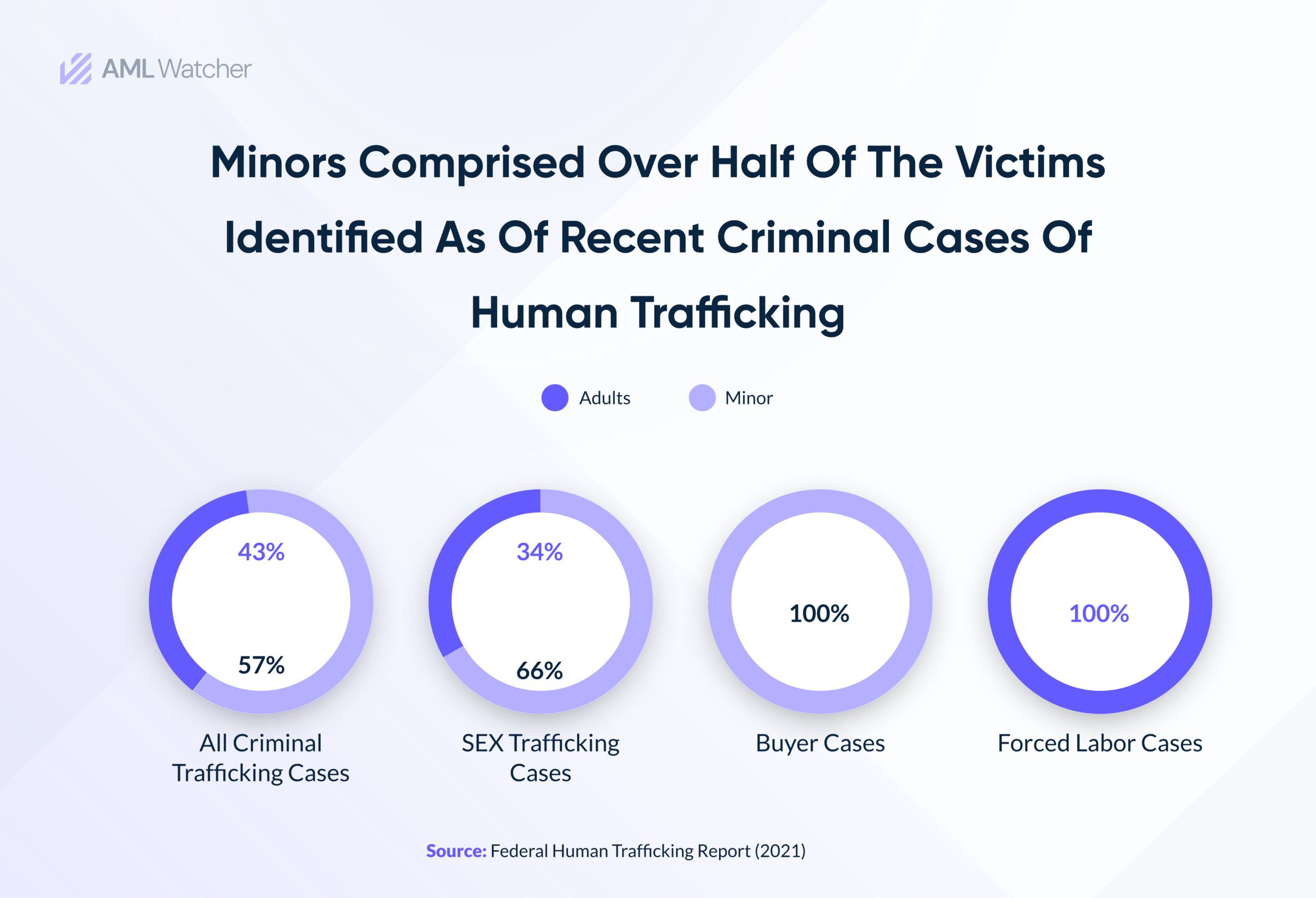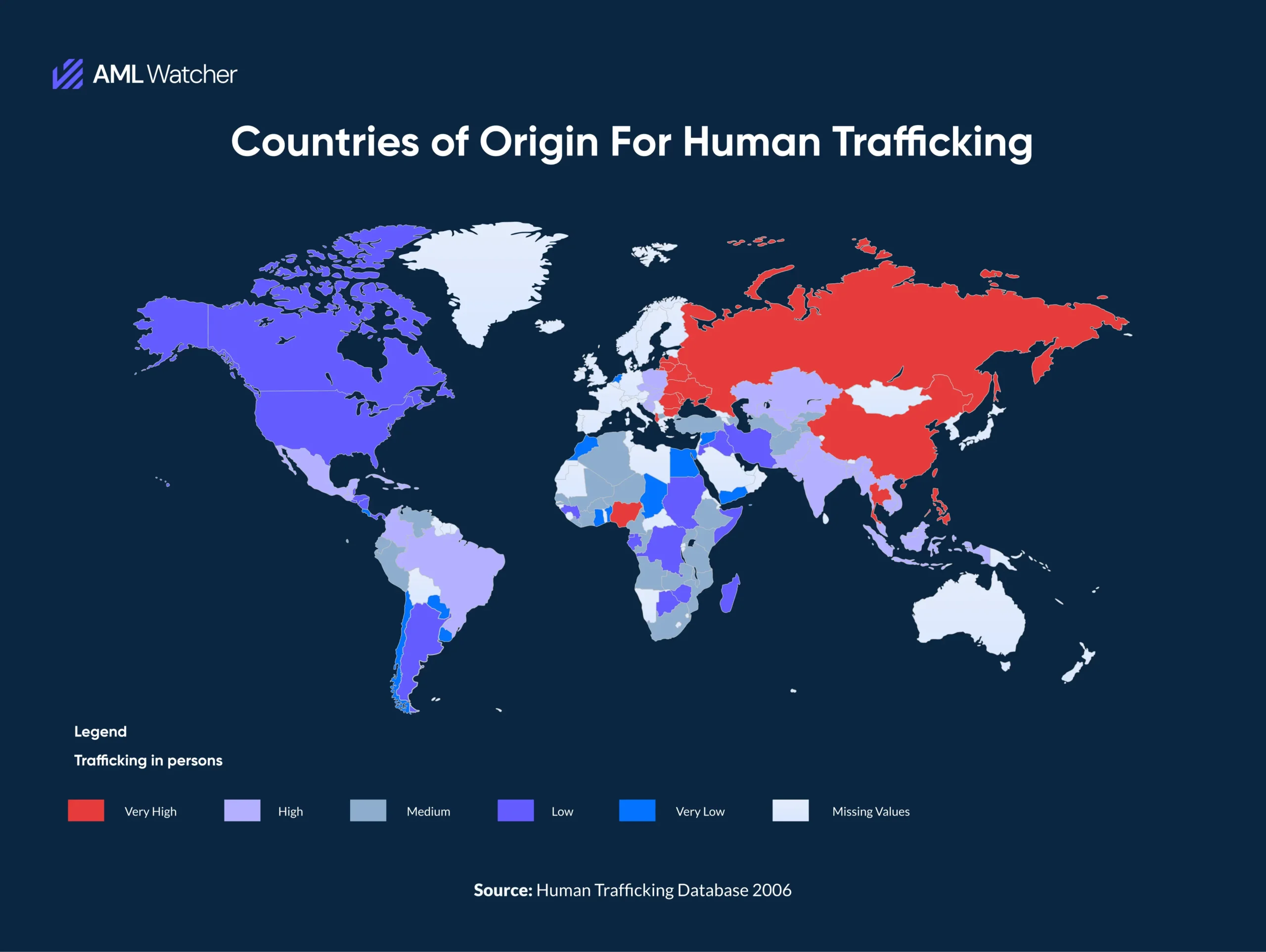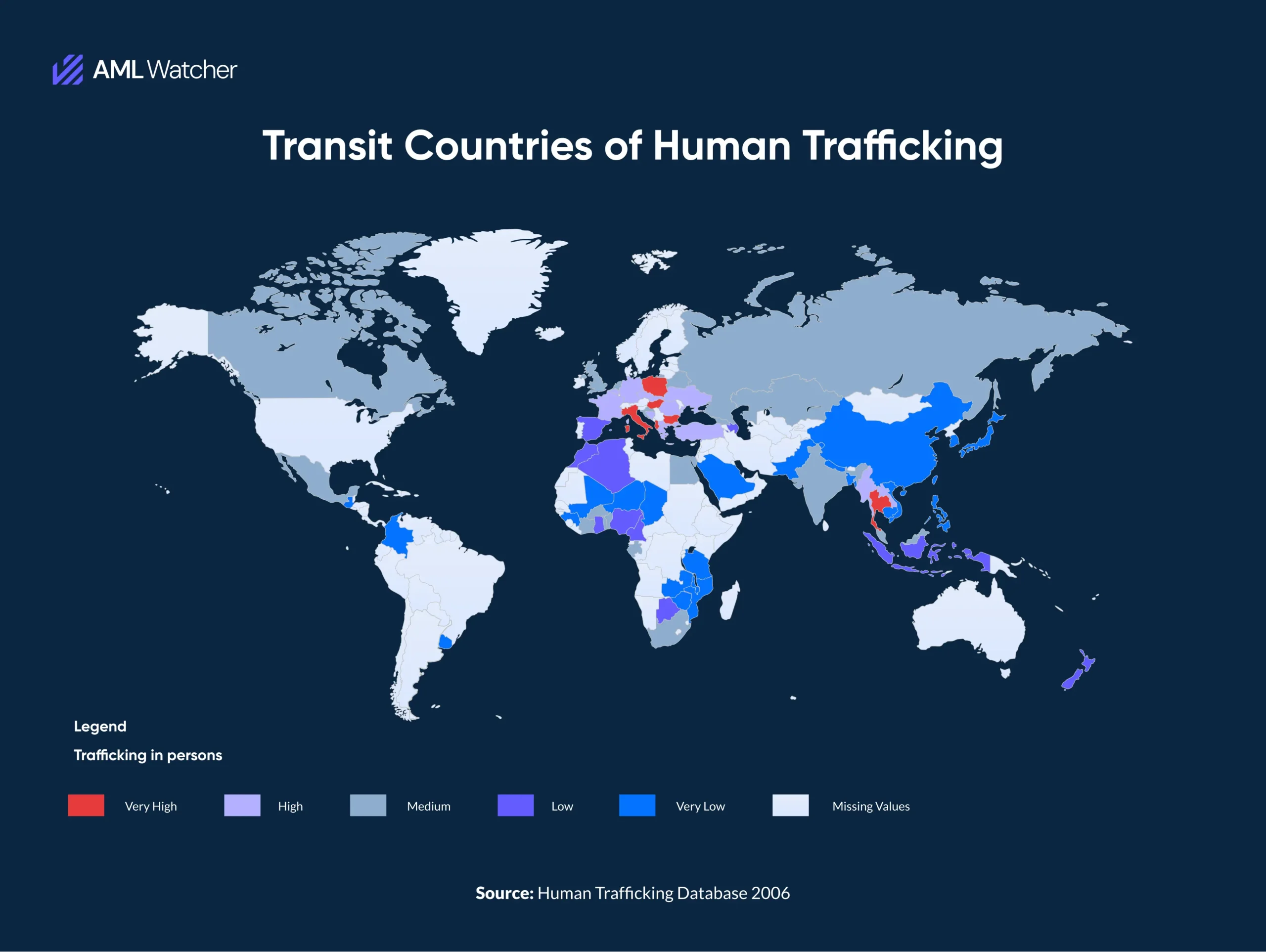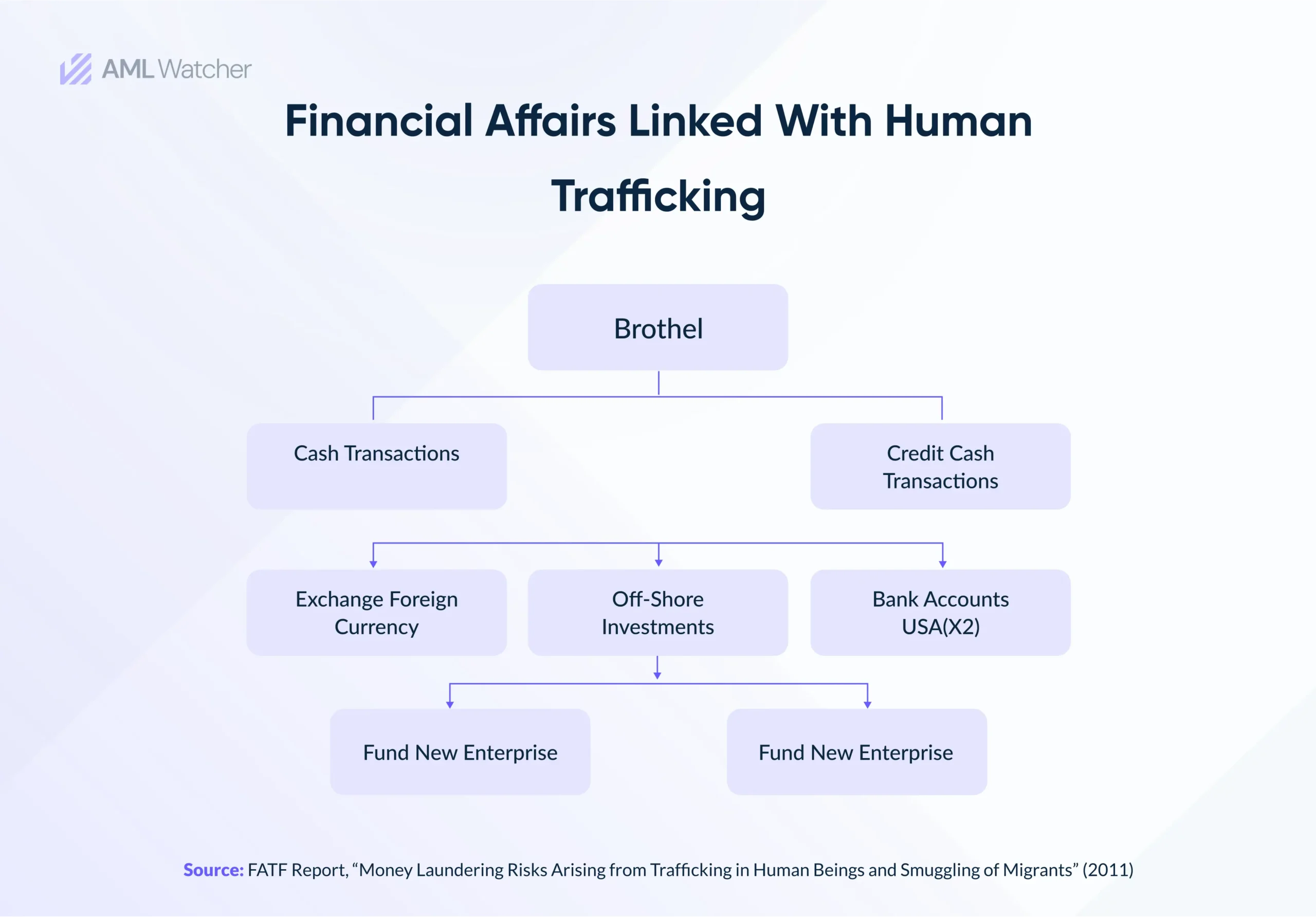Human Trafficking, Financial Institutions, & Money Laundering - Connections & Solutions?
Every year, millions fall victim to Human Trafficking. Learn how your bank is part of the solution.
How Illicit Flow of Money Is a Silent Enabler of Human Trafficking?
Trafficking in Human Beings (THB) is currently the third largest crime enterprise in the world, right after drug smuggling ranking on second and arms trafficking coming at the top. Before the year 2000, no mutually agreed-upon definition of human trafficking existed. This evolved right after 2000, when the United Nations defined and declared the “Protocol to Prevent, Suppress, and Punish Human Trafficking, Especially Among Women and Children” (commonly known as the Trafficking Protocol) in Palermo, Sicily.
Human Trafficking is one of the most profitable crime, hence a large number of criminals have turned to it in recent decades. Currently, 2.45 million people are reported to have become the victims of human trafficking. Human trafficking results in USD 32 billion in profits for its operators as per the FATF report.
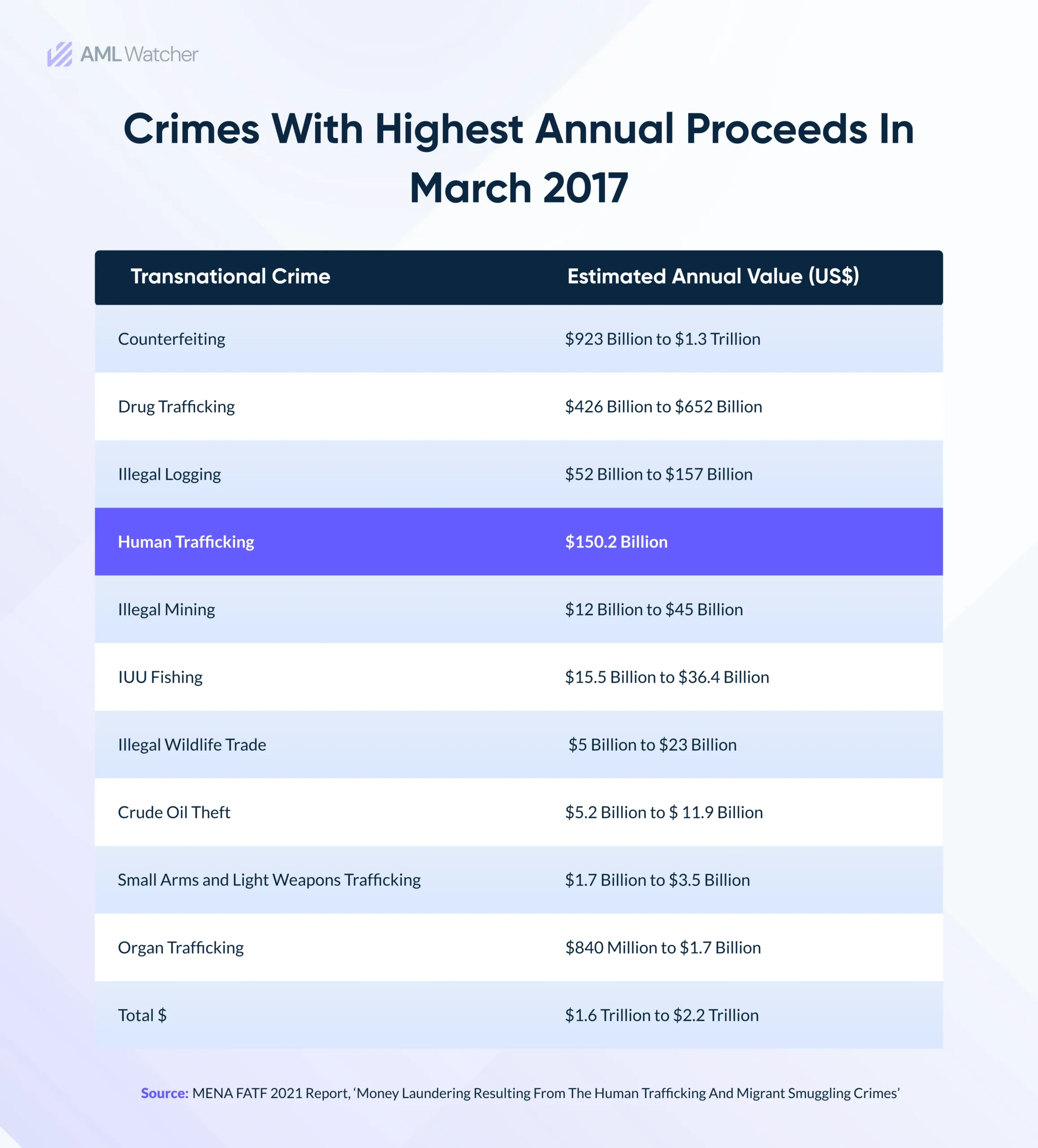
Money laundering is typically investigated by law enforcement agencies. Financial Intelligence Units (FIUs) also investigate human trafficking cases that involve money laundering, which explains how investigations carried out by the FIU and law enforcement agencies, as well as suspicious transaction reports, tend to be the key sources of information. The difficulty in detecting suspicious transactions of cash linked to human trafficking, gathering sufficient evidence, and limited transnational collaboration all pose hurdles to effectively fight against human trafficking-related money laundering.
How Is Human Trafficking Linked to Money Laundering?
Human Trafficking allows illicit flow of dirty money in the following circumstances:
- When payments are made for the transportation of victims, and dealing with miscellaneous logistics, for example, plane tickets, hotels, guest rooms, etc.
- When profits are generated out of exploitation of trafficked victims.
- When transactions are made for bribery to facilitate human trafficking operations.
- When certain material goods are purchased by the perpetrators using profits generated from the exploitation of trafficked victims.
Human trafficking operations that cause the movement of illicit financial activity are considered as means to facilitate money laundering. In a number of cases, profits made from exploitation of victims are used to finance terrorist operations around the world as in the case of ISIS in Syria.
Countries of Origin For Human Trafficking
According to the Europol report on “Trafficking of women and children for sexual exploitation in the EU: the involvement of Western Balkans Organised Crime,” human trafficking takes place in number of countries including Bulgaria, Albania, Romania, Nigeria, and Moldova. This is also followed by cases where government itself is involved. Countries of origin for human trafficking are usually states where the general population struggles with poverty and lack of education due to political instability and economic turmoil. In countries like these, parents end up selling their children for money, or sending them abroad for labor opportunities.
Worst countries that are known as the countries of origin for human trafficking are
- Western African countries like Senegal, Ghana, Niger, & Mali.
- SouthEast Asian countries like Vietnam, Cambodia, China, and others.
- South Asian countries like Nepal, India, Pakistan etc.
- Central & South Eastern European states which include former Soviet Republics like Ukraine, Belarus, Azerbaijan, Armenia, Kazakhstan, Kyrgyz Republic, Tajikistan, Uzbekistan, Turkmenistan, and the Russian Federation.
- South American countries in particular Brazil, Mexico, Argentina, Ecuador, and Colombia.
Transit Countries of Human Trafficking
According to the Europol report on “Trafficking of women and children for sexual exploitation in the EU: the involvement of Western Balkans Organised Crime,” human trafficking takes place in number of countries including Bulgaria, Albania, Romania, Nigeria, and Moldova. This is also followed by cases where government itself is involved. Countries of origin for human trafficking are usually states where the general population struggles with poverty and lack of education due to political instability and economic turmoil. In countries like these, parents end up selling their children for money, or sending them abroad for labor opportunities.
Countries of Destination For Human Trafficking
Destination nations typically provide greater work prospects and are more developed and economically affluent. The United States, United Kingdom, and Europe states like Germany, France, Netherlands, Greece, Italy, Spain, Austria, and Belgium are currently the most popular destinations for human trafficking. There is a higher need for trafficked people over there as the general population tends to have more resources to avail the services provided by trafficked individuals.
US Regulations to Prevent Human Trafficking
The US has come up with financial sanctions in several ways to prevent human trafficking. These sanctions target those who engage in these activities with sanctions covering their roles under more general umbrella terms. The current set of measures includes asset freezes, travel bans, and listings on the US' Specially Designated Nationals and Blocked Persons List, which blocks assets and forbids US persons from dealing with them.The US' sanctions have no effect currently involve some of the more severe financial sector sanctions that have been imposed against some targets, like Venezuela Russia, and Syria.
How Financial Institutions Can Identify Red Flags Indicating Money Laundering From Human Trafficking?
The red flags that indicate money laundering risks relating to human trafficking are generally applicable to other categories of crimes too. However, some of the unique red flag indicators that are specific to money laundering associated with human trafficking are as follows.
As per the OSCE report “Analyzing the Business Model of Trafficking in Human Beings to Better Prevent the Crime”, typically human trafficking involves the following patterns:
- Human trafficking operators invest the proceeds of their exploitation in legal businesses like real estate, hotels, election campaigns, restaurants, the entertainment industry and so on.
- They invest in a lush lifestyle for themselves in the country of origin and destination countries.
- They often use the funds to conduct criminal activities in the country of origin and the country of destination
For the above-mentioned patterns, they use cash transactions and very often employ the following services:
- Cash Couriers
- Money Service Businesses (such as money remitters)
- Cash Based activities (e.g., mobile phone selling)
- Hawala (informal banking system)
- Cash Converter Activities (e.g. casinos)
For the above-mentioned patterns, they use cash transactions and very often employ the following services:
- Cash Couriers
- Money Service Businesses (such as money remitters)
- Cash Based activities (e.g., mobile phone selling)
- Hawala (informal banking system)
- Cash Converter Activities (e.g. casinos)
Key Indicators For Money Service Businesses (MSBs)
These are businesses that facilitate money movement and currency exchange. Their service to facilitate the transfer of large sums of money makes them vulnerable to the illicit flow of ill-gotten funds. Therefore, to detect money laundering associated with human trafficking, money service business must keep their eyes on the following customer behavior patterns:
- When a customer makes a small amount of multiple transactions to evade detection.
- When a customer makes small transactions in high frequency in an attempt to obscure the origin of their ill-gotten gains.
- When a customer makes frequent transactions to high-risk countries with weak AML regulations and high frequency of money laundering cases.
- When different customers make international transactions to the same beneficiary residing in the high-risk countries.
Key Indicators For Dealers in High-Value Goods
Businesses in high value goods like luxury cars, designer clothing, expensive watches, art dealers, and jewelers are highly prone to money laundering since these items can help disclose the origin of ill-gotten gains in a single massive transaction.
- When a customer makes a large cash payment to purchase a high value item. Since the source of origin for cash payments are near impossible to trace down.
- When a customer purchases a high value item and then sends it overseas.
Key Indicators For Casinos
Casinos all round the world offer various services that involve massive amounts of cash money which makes this industry a preferable choice for money launderers. To avoid the consequences of non-compliance, authorities must be vigilant about the following circumstance
- Purchase of gaming chips that can be redeemed after a minimum amount of gaming, which suggests that this entails purchasing chips, engaging in little to no real gaming, and then cashing out the chips. This may cause illegal money to seem like gains from gambling.
- Refining activities, or turning tiny bills into large ones, suggests that handling huge amounts of money and making them appear less suspicious when deposited in banks can be facilitated by exchanging small bills for larger ones.
- Cash deposits into bank drafts for casino front money accounts imply that money is deposited in front money accounts at casinos prior to gaming. It is possible to bring illegal funds into the financial system by making sizable cash deposits into these accounts.
Case Study: Use of Offshore Investments For Sex Trafficking
Years ago, the financial activities of a popular brothel in South Africa were investigated and its owner was found to be managing human trafficking operations. This brothel received its trafficked victims from Eastern European states like Ukraine, Bulgaria, and Romania. The brothel appearantly operated as a striped club, but behind the scenes, it actually provided services like any brothel.
The investigation led to the following revelations:
- This brothel never employed any banking services. Cash transactions were the primary method for conducting financial transactions.
- A massive amount of foreign currency including euros, pounds, and dollars was confiscated from the owner of the brothel during airport security searches which revealed that the owner used foreign currencies during business activities.
- The owner also had offshore investment made through Guernsey Trust revealed in the investigation.
- The owner employed US banking services and later moved his assets to Guernsey Trust which again were moved back to South Africa to invest in two new business ventures.
- The owner was found to have profited GBP 40 million by managing his brothel venture in South Africa.
Financial services can be easily used by traffickers to profit from their operations if financial institutions are not adequately regulated. Financial services companies are suggested to create public-private partnerships with the government, anti-trafficking organizations, and survivor leaders in order to better inform their programs and combat human trafficking. One such partnership could involve creating risk indicators to identify customers who are both victims and offenders of human trafficking.
Fighting against human trafficking is a significant endeavor, and anti-money laundering (AML) measures can be crucial in stopping the money flows that fuel this illegal activity.
Subscribe to our Newsletter
Our best articles, news and stories, delivered to your inbox every week.
